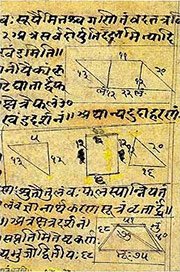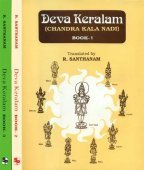Vasudha, Vasudhā, Vasu-dha: 19 definitions
Introduction:
Vasudha means something in Hinduism, Sanskrit, Buddhism, Pali, the history of ancient India, Marathi, biology. If you want to know the exact meaning, history, etymology or English translation of this term then check out the descriptions on this page. Add your comment or reference to a book if you want to contribute to this summary article.
In Hinduism
Pancaratra (worship of Nārāyaṇa)
Source: Wisdom Library: PāñcarātraVasudhā (वसुधा, “wealth producing”):—One of the twenty-four emanations of Lakṣmī accompanying Nārāyaṇa. This particular manifestation couples with his counterpart form called Puruṣottama and together they form the seventeenth celestial couple. Lakṣmī represents a form of the Goddess (Devī) as the wife of Viṣṇu, while Nārāyaṇa represents the personification of his creative energy, according to the Pāñcarātra literature.

Pancaratra (पाञ्चरात्र, pāñcarātra) represents a tradition of Hinduism where Narayana is revered and worshipped. Closeley related to Vaishnavism, the Pancaratra literature includes various Agamas and tantras incorporating many Vaishnava philosophies.
Purana and Itihasa (epic history)
Source: archive.org: Puranic EncyclopediaVasudhā (वसुधा).—Daughter of Narmadā, a Gandharva woman. Narmadā had three daughters Sundarī, Ketumatī and Vasudhā. (For more details see under Puṣpotkaṭā).
Source: archive.org: Shiva Purana - English TranslationVasudhā (वसुधा) refers to the “earth”, according to the Śivapurāṇa 2.3.15 (“The penance and reign of Tārakāsura”).—Accordingly, as Brahmā narrated: “[...] At the same time, several phenomena of evil portent forboding misery and distress happened, when the son of Varāṅgī was born making the gods miserable. [...] The earth [i.e., vasudhā] with all the mountains quaked; the quarters blazed; the rivers and oceans were particularly agitated. The rough wind blew with a hissing noise. Gusts of wind with troops of tempests and dust for banner uprooted several trees. [...]”.
Source: Cologne Digital Sanskrit Dictionaries: The Purana Index1a) Vasudhā (वसुधा).—(also Vasundharā); ety. of.*
- * Brahmāṇḍa-purāṇa II. 37. 1; 36. 226; Vāyu-purāṇa 63. 1.
1b) The deity to be remembered in installing a new image; the presiding deity is Śarva.*
- * Matsya-purāṇa 265. 38, 40.

The Purana (पुराण, purāṇas) refers to Sanskrit literature preserving ancient India’s vast cultural history, including historical legends, religious ceremonies, various arts and sciences. The eighteen mahapuranas total over 400,000 shlokas (metrical couplets) and date to at least several centuries BCE.
Jyotisha (astronomy and astrology)
Source: Wikibooks (hi): Sanskrit Technical TermsVasudhā (वसुधा).—1. Base of a triangle. 2. Earth. Note: Vasudhā is a Sanskrit technical term used in ancient Indian sciences such as Astronomy, Mathematics and Geometry.

Jyotisha (ज्योतिष, jyotiṣa or jyotish) refers to ‘astronomy’ or “Vedic astrology” and represents the fifth of the six Vedangas (additional sciences to be studied along with the Vedas). Jyotisha concerns itself with the study and prediction of the movements of celestial bodies, in order to calculate the auspicious time for rituals and ceremonies.
Kavya (poetry)
Source: Brill: Śaivism and the Tantric Traditions (kavya)Vasudhā (वसुधा) refers to the “earth”, according to Kālidāsa’s Raghuvaṃśa verse 8.84.—Accordingly: “So do not think about her death. Those who have been born will surely die. Have regard for this Earth (vasudhā—vasudheyam), for the Earth is the true wife of kings”.

Kavya (काव्य, kavya) refers to Sanskrit poetry, a popular ancient Indian tradition of literature. There have been many Sanskrit poets over the ages, hailing from ancient India and beyond. This topic includes mahakavya, or ‘epic poetry’ and natya, or ‘dramatic poetry’.
Ganitashastra (Mathematics and Algebra)
Source: archive.org: Hindu MathematicsVasudhā (वसुधा) represents the number 1 (one) in the “word-numeral system” (bhūtasaṃkhyā), which was used in Sanskrit texts dealing with astronomy, mathematics, metrics, as well as in the dates of inscriptions and manuscripts in ancient Indian literature.—A system of expressing numbers by means of words arranged as in the place-value notation was developed and perfected in India in the early centuries of the Christian era. In this system the numerals [e.g., 1—vasudhā] are expressed by names of things, beings or concepts, which, naturally or in accordance with the teaching of the Śāstras, connote numbers.

Ganitashastra (शिल्पशास्त्र, gaṇitaśāstra) refers to the ancient Indian science of mathematics, algebra, number theory, arithmetic, etc. Closely allied with astronomy, both were commonly taught and studied in universities, even since the 1st millennium BCE. Ganita-shastra also includes ritualistic math-books such as the Shulba-sutras.
India history and geography
Source: Cologne Digital Sanskrit Dictionaries: Indian Epigraphical GlossaryVasudhā.—(IE 7-1-2), ‘one’. Note: vasudhā is defined in the “Indian epigraphical glossary” as it can be found on ancient inscriptions commonly written in Sanskrit, Prakrit or Dravidian languages.

The history of India traces the identification of countries, villages, towns and other regions of India, as well as mythology, zoology, royal dynasties, rulers, tribes, local festivities and traditions and regional languages. Ancient India enjoyed religious freedom and encourages the path of Dharma, a concept common to Buddhism, Hinduism, and Jainism.
Biology (plants and animals)
Source: Google Books: CRC World Dictionary (Regional names)Vasudha in India is the name of a plant defined with Phoenix sylvestris in various botanical sources. This page contains potential references in Ayurveda, modern medicine, and other folk traditions or local practices It has the synonym Elate versicolor Salisb. (among others).
Example references for further research on medicinal uses or toxicity (see latin names for full list):
· J. Investig. Allergol. Clin. Immunol. (2006)
· Hortus Bengalensis, or ‘a Catalogue of the Plants Growing in the Hounourable East India Company's Botanical Garden at Calcutta’ (1814)
· Prodromus Stirpium in Horto ad Chapel Allerton vigentium (1796)
· Species Plantarum
· Enumeratio Plantarum Zeylaniae (1864)
· Flora Indica (1832)
If you are looking for specific details regarding Vasudha, for example pregnancy safety, health benefits, chemical composition, diet and recipes, side effects, extract dosage, have a look at these references.

This sections includes definitions from the five kingdoms of living things: Animals, Plants, Fungi, Protists and Monera. It will include both the official binomial nomenclature (scientific names usually in Latin) as well as regional spellings and variants.
Languages of India and abroad
Pali-English dictionary
Source: BuddhaSasana: Concise Pali-English Dictionaryvasudhā : (f.) the earth.

Pali is the language of the Tipiṭaka, which is the sacred canon of Theravāda Buddhism and contains much of the Buddha’s speech. Closeley related to Sanskrit, both languages are used interchangeably between religions.
Marathi-English dictionary
Source: DDSA: The Aryabhusan school dictionary, Marathi-Englishvasudhā (वसुधा).—f The earth.
Marathi is an Indo-European language having over 70 million native speakers people in (predominantly) Maharashtra India. Marathi, like many other Indo-Aryan languages, evolved from early forms of Prakrit, which itself is a subset of Sanskrit, one of the most ancient languages of the world.
Sanskrit dictionary
Source: DDSA: The practical Sanskrit-English dictionaryVasudhā (वसुधा).—
1) the earth; वसुधेयमवेक्ष्यतां त्वया (vasudheyamavekṣyatāṃ tvayā) R.8.83; पुरा सप्तद्वीपां जयति वसुधामप्रतिरथः (purā saptadvīpāṃ jayati vasudhāmapratirathaḥ) Ś.7.35;1.25.
2) the heaven; धरान् धरित्रीं वसुधां भर्तुस्तिष्ठाम्यनन्तरम् (dharān dharitrīṃ vasudhāṃ bhartustiṣṭhāmyanantaram) Mahābhārata (Bombay) 13.93.1 (com. vasūn devān dhatte iti vyutpattyā vasudhāṃ divam).
3) the ground; वसुधालिङ्गनधूसरस्तनी (vasudhāliṅganadhūsarastanī) Kumārasambhava 4.4. °अधिपः (adhipaḥ) a king. °धरः (dharaḥ) a mountain; वसुधाधरकन्दराभिसर्पी प्रतिशब्दोऽपि हरेर्भिनत्ति नागान् (vasudhādharakandarābhisarpī pratiśabdo'pi harerbhinatti nāgān) V.1.18. °नगरम् (nagaram) the capital of Varuṇa.
Vasudhā is a Sanskrit compound consisting of the terms vasu and dhā (धा).
Source: Cologne Digital Sanskrit Dictionaries: Shabda-Sagara Sanskrit-English DictionaryVasudhā (वसुधा).—f.
(-dhā) The earth. E. vasu wealth, dhā to have or contain, affs. ka and ṭāp .
Source: Cologne Digital Sanskrit Dictionaries: Benfey Sanskrit-English DictionaryVasudhā (वसुधा).—[vasu-dhā], f. The earth, [Vikramorvaśī, (ed. Bollensen.)] [distich] 16.
Source: Cologne Digital Sanskrit Dictionaries: Cappeller Sanskrit-English DictionaryVasudhā (वसुधा).—[adjective] yielding good, liberal. [feminine] the earth, land.
Source: Cologne Digital Sanskrit Dictionaries: Monier-Williams Sanskrit-English Dictionary1) Vasudhā (वसुधा):—[=vasu-dhā] [from vasu > vas] mfn. producing wealth, liberal (-tama mfn., -tara mfn. more or most l°), [Atharva-veda; Vājasaneyi-saṃhitā; Taittirīya-saṃhitā]
2) [v.s. ...] f. the earth
3) [v.s. ...] a country, kingdom, [Manu-smṛti; Mahābhārata; Kāvya literature] etc.
4) [v.s. ...] the ground, soil, [Varāha-mihira’s Bṛhat-saṃhitā]
5) [v.s. ...] earth (as a material), [Rāmāyaṇa]
6) [v.s. ...] Name of Lakṣmī, [Viṣṇu-smṛti, viṣṇu-sūtra, vaiṣṇava-dharma-śāstra]
7) [v.s. ...] an anapaest, [Piṅgala Scholiast, i.e. halāyudha]
Source: Cologne Digital Sanskrit Dictionaries: Yates Sanskrit-English DictionaryVasudhā (वसुधा):—(dhā) 1. f. The earth.
Source: DDSA: Paia-sadda-mahannavo; a comprehensive Prakrit Hindi dictionary (S)Vasudhā (वसुधा) in the Sanskrit language is related to the Prakrit word: Vasuhā.
[Sanskrit to German]
Sanskrit, also spelled संस्कृतम् (saṃskṛtam), is an ancient language of India commonly seen as the grandmother of the Indo-European language family (even English!). Closely allied with Prakrit and Pali, Sanskrit is more exhaustive in both grammar and terms and has the most extensive collection of literature in the world, greatly surpassing its sister-languages Greek and Latin.
See also (Relevant definitions)
Partial matches: Vasu, Dha, Ta.
Starts with (+16): Vacutai, Vacutarai, Vacutataram, Vasudhacakra, Vasudhadhara, Vasudhadhatri, Vasudhadhava, Vasudhadhipa, Vasudhadhipati, Vasudhadhipatya, Vasudhagama, Vasudhakharjurika, Vasudhamara, Vasudhana, Vasudhanagara, Vasudhanayaka, Vasudhapala, Vasudhaparipalaka, Vasudhapati, Vasudhara.
Ends with: Govindarcanavasudha, Janmavasudha, Kshetravasudha, Ruddhavasudha, Samaravasudha, Tattvasudha.
Full-text (+42): Vasudhadhara, Vasudhadhipa, Vasudhanagara, Kshetravasudha, Vasudhatama, Vasudhatara, Vasudhadhatri, Vasudhapati, Vasudharenu, Vasudhadhava, Vasudhavilasin, Vasudhanayaka, Vasudhaparipalaka, Vasudhasuta, Vasudhakharjurika, Vasudhatala, Vasudhadhipatya, Vasudhagama, Ardray, Ardrayati.
Relevant text
Search found 20 books and stories containing Vasudha, Vasudhā, Vasu-dha, Vasu-dhā; (plurals include: Vasudhas, Vasudhās, dhas, dhās). You can also click to the full overview containing English textual excerpts. Below are direct links for the most relevant articles:
A Boat Ride < [July – September, 2007]
Manusmriti with the Commentary of Medhatithi (by Ganganatha Jha)
Verse 6.68 < [Section VI - Procedure of going forth as a Wandering Mendicant]
Puranic encyclopaedia (by Vettam Mani)
Garga Samhita (English) (by Danavir Goswami)
Verse 4.20.12 < [Chapter 20 - The Killing of Pralamba]
Verse 5.15.24 < [Chapter 15 - Seeing Sri Radha]
Verses 1.13.9-10 < [Chapter 13 - The Liberation of Pūtanā]
Harshacharita (socio-cultural Study) (by Mrs. Nandita Sarmah)
Part 9: Arms, Army and Warfare (Introduction) < [Chapter 5 - Political Aspects]
16. Art and Architecture < [Chapter 6 - Other Socio-Cultural Aspects]
3. Environmental Awareness in 7th century India < [Chapter 7 - Environmental awareness and Hygiene Conciousness]
Sahitya-kaumudi by Baladeva Vidyabhushana (by Gaurapada Dāsa)
Text 10.94 < [Chapter 10 - Ornaments of Meaning]
Related products
